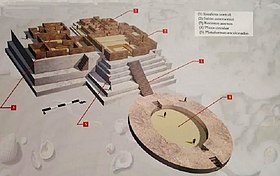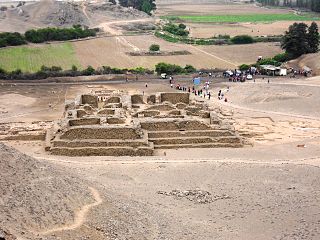
The Sacred City of Caral-Supe, or simply Caral, is an archaeological site in Peru where the remains of the main city of the Caral civilization are found. It is located in the Supe valley of Peru, near the current town of Caral, 182 kilometers north of Lima, 23 km from the coast and 350 metres above sea level. It is attributed an antiquity of 5,000 years and it is considered the oldest city in the Americas and one of the oldest in the world. No other site has been found with such a diversity of monumental buildings or different ceremonial and administrative functions in the Americas as early as Caral. It has been declared a Humanity Cultural Heritage site by UNESCO.

Ruth Martha Shady Solís is a Peruvian anthropologist and archaeologist. She is the founder and director of the archaeological project at Caral.

Peruvian territory was inhabited 14,000 years ago by hunters and gatherers. Subsequent developments include the appearance of sedentary communities that developed agriculture and irrigation, and the emergence of complex socio-political hierarchies that created sophisticated civilizations, technology and monumental construction.
Huaricanga is the earliest city of the Norte Chico civilization, called Caral or Caral-Supe in Peru and Spanish language sources. "It existed around 3500 BC and was the oldest city in the Americas and one of the earliest cities in the world." This Late Archaic site is located in the arid Fortaleza Valley on Peru’s north central coast. It is 14 mi (23 km) inland from the Pacific Ocean. The site covers a total area of 100 hectares, and is the largest Late Archaic construction in the Norte Chico region.

Caral-Supe was a complex pre-Columbian-era society that included as many as thirty major population centers in what is now the Caral region of north-central coastal Peru. The civilization flourished between the fourth and second millennia BC, with the formation of the first city generally dated to around 3500 BC, at Huaricanga, in the Fortaleza area. It is from 3100 BC onward that large-scale human settlement and communal construction become clearly apparent, which lasted until a period of decline around 1800 BC. Since the early twenty-first century, it has been established as the oldest-known civilization in the Americas, and as one of the six sites where civilisation separately originated in the ancient world.

Ventarrón is the site of a 4,500-year-old temple with painted murals, which was excavated in Peru in 2007 near Chiclayo, in the Lambayeque region on the northern coast. The site was inhabited by the Early Cupisnique, Cupisnique, Chavin and Moche cultures.

Cerro Sechín is an archaeological site in Casma Province of Ancash Region in northern Peru. Dating to 1600 BC, the site was discovered by Peruvian archaeologists Julio C. Tello and Toribio Mejía Xesspe on July 1, 1937. Tello believed it was the capital of an entire culture, now known as the Casma/Sechin culture or Sechin complex. Notable features include megalithic architecture with carved figures in bas-relief, which graphically dramatize human sacrifices. Cerro Sechín is situated within the Sechin Alto Complex, as are Sechin Bajo, and Taukachi-Konkan. There is a small on-site museum. The slabs at Cerro Sechin may represent the central Andes' oldest known monumental sculpture.

The Lima culture was an indigenous civilization which existed in modern-day Lima, Peru during the Early Intermediate Period, extending from roughly 100 to 650. This pre-Incan culture, which overlaps with surrounding Paracas, Moche, and Nasca civilizations, was located in the desert coastal strip of Peru in the Chillon, Rimac and Lurin River valleys. It can be difficult to differentiate the Lima culture from surrounding cultures due to both its physical proximity to other, and better documented cultures, in Coastal Peru, and because it is chronologically very close, if not over lapped, by these other cultures as well. These factors all help contribute to the obscurity of the Lima culture, of which much information is still left to be learned.

The Andean civilizations were South American complex societies of many indigenous people. They stretched down the spine of the Andes for 4,000 km (2,500 mi) from southern Colombia, to Ecuador and Peru, including the deserts of coastal Peru, to north Chile and northwest Argentina. Archaeologists believe that Andean civilizations first developed on the narrow coastal plain of the Pacific Ocean. The Caral or Norte Chico civilization of coastal Peru is the oldest known civilization in the Americas, dating back to 3500 BCE. Andean civilization is one of the six "pristine" civilizations of the world, created independently and without influence by other civilizations.
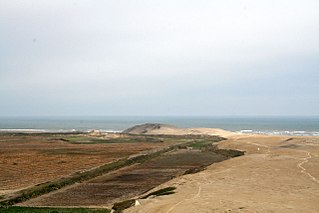
Huaca Prieta is the site of a prehistoric settlement beside the Pacific Ocean in the Chicama Valley, just north of Trujillo, La Libertad Province, Peru. It is a part of the El Brujo Archaeological Complex, which also includes Moche (culture) sites.

The history of human habitation in the Andean region of South America stretches from circa 15,000 BCE to the present day. Stretching for 7,000 km (4,300 mi) long, the region encompasses mountainous, tropical and desert environments. This colonisation and habitation of the region has been affected by its unique geography and climate, leading to the development of unique cultural and socn.

The Kotosh Religious Tradition is a term used by archaeologists to refer to the ritual buildings that were constructed in the mountain drainages of the Andes between circa 3000 and c. 1800 BCE, during the Andean preceramic, or Late Archaic period of Andean history.
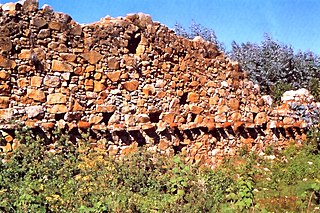
Viracochapampa, Huiracochapampa, or Wiracochapampa is an archaeological site with the remains of a building complex of ancient Peru of pre-Inca times. It was one of the administrative centers of the Wari culture. Viracochapampa is located about 3.5 km north of Huamachuco in the region of La Libertad at an elevation of 3,070 metres (10,072 ft).
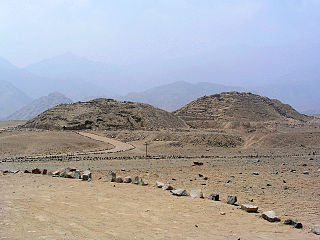
The Andean preceramic refers to the early period of human occupation in the Andean area of South America that preceded the introduction of ceramics. This period is also called pre-ceramic or aceramic.

Ancon (archaeological site) is located in the north of the Bay of Ancon, in the Ancón District, on the central coast of Peru. It is one of the most important centers of the Peruvian archeology and features a vast necropolis of the pre-Hispanic era, with countless funerary sites. Permanent occupation in Ancon is documented throughout all periods of Andean history. The oldest evidence of human occupation dates back 10,000 years ago to the preceramic period.

Las Haldas or Las Aldas is a large archaeological complex from before and during the initial ceramic period of Peru. Las Haldas is located on the Pacific coast approximately 300 kilometres (190 mi) north of Lima and about 20 kilometres (12 mi) south of the Casma river valley, noted for the extensive ruins of the Casma–Sechin culture. For most of its history Las Haldas, a coastal community, coexisted with the inland agricultural communities in the Casma River Valley.

Bandurria is a large archaeological site on the Huaura River in Peru that has been dated to 4,000 BC. It is located about 3 km south of the city of Huacho, in Huacho District, Huaura Province, Lima Region. It corresponds chronologically to the period known as the 'Late Archaic' or 'Late preceramic' covering the years from about 4000 to 2000 BC.
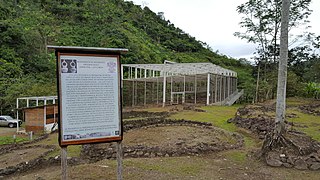
Santa Ana (La Florida) is an important archaeological site in the highlands of Ecuador, going back as early as 3,500 BC. It is located in the Palanda Canton, just to the north of its regional capital of es:Palanda, in the Zamora-Chinchipe Province of Ecuador.

A huanca or chichic (tsitsiq) is an elongated vertical stone considered sacred, with multiple symbolisms, in the Andean worldview. Huancas were worshipped and given rituals and offerings. The stone placed at the top is called chacrayoc;.
